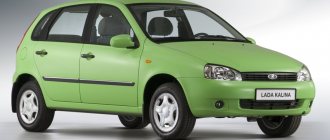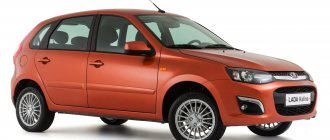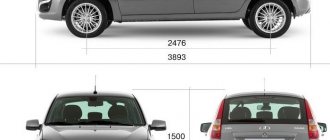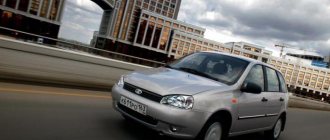Main characteristics
| Brand | VAZ |
| Model | Lada Priora Hatchback |
| Modification | Lada Priora Hatchback 1.6 MT 98 hp |
| Model year | 2013 |
| Body type | Hatchback |
| Number of doors | 5 |
| Number of seats | 5 |
| Country of assembly | Russia |
Performance characteristics
| Type of fuel | AI-95 |
| Acceleration time to 100 km/h | 11.5 sec |
| Maximum speed | 183 km/h |
| Fuel consumption in the urban cycle | 9.1 l per 100 km |
| Fuel consumption on the highway | 5.5 l per 100 km |
| Combined fuel consumption | 6.9 l per 100 km |
| Power reserve | 473 – 782 km |
| Fuel costs per year (with a mileage of 100 km per day) | 119 629₽ |
| Transport tax * (Moscow) | 1 176₽ |
| OSAGO * (Moscow, age over 22 years, experience over 3 years) | 7 570₽ |
* Use Tax and OSAGO calculators for more detailed calculations.
Dimensions and dimensions
| Length | 4210 mm |
| Width | 1680 mm |
| Height | 1435 mm |
| Ground clearance | 165 mm |
| Front track | 1410 mm |
| Rear track | 1380 mm |
| Wheelbase | 2492 mm |
| Turning diameter | 11.6 m |
Weight
| Curb weight | 1163 kg |
| Full mass | 1578 kg |
| Load capacity | 415 kg |
Volumes
| Trunk volume | 360 l |
| Fuel tank volume | 43 l |
Engine
| engine's type | Petrol |
| Number of cylinders / arrangement | 4/Inline |
| Engine power, hp/rpm | 98/5600 |
| Engine displacement | 1596 cm³ |
| Torque, Nm/rpm | 145/4000 |
Transmission
| Drive unit | Front |
| Gearbox type | Mechanical, 5 gears |
Body
What could the new model be?
Render of the 2021 Priora in a new body
In the last year of its release of the new body, the Lada Priora completely lost its popularity (not counting, of course, the market of the North Caucasus and, mainly, the Chechen Republic) and flew out of the TOP 25 best-selling cars in Russia.
At the same time, its closest “relatives”, the new Vesta 2021 model year and Granta, firmly established themselves in the top three, which rightfully attracted the vast majority of the production and investment potential that AvtoVAZ had.
But the model also had defenders - enthusiasts who assured that the Lada Priora 2022 could return to the market, for example, with an updated exterior, trying on the signature X-face. In reality, these plans turned out to be unrealized, and the car clearly required a transition to a new platform, which would have meant huge financial investments.
Modifications of Lada Priora
Lada Priora 1.6 AMT
| Maximum speed, km/h | 183 |
| Acceleration time to 100 km/h, sec | 11.4 |
| Engine | Petrol |
| Working volume, cm3 | 1596 |
| Power, hp / rpm | 106/5800 |
| Torque, Nm/rpm | 148/4200 |
| Combi consumption, l per 100 km | 6.6 |
| Gearbox type | Robotic, 5 gears |
| Drive unit | Front |
Lada Priora 1.6 MT
| Maximum speed, km/h | 176 |
| Acceleration time to 100 km/h, sec | 12.5 |
| Engine | Petrol |
| Working volume, cm3 | 1596 |
| Power, hp / rpm | 87/5100 |
| Torque, Nm/rpm | 140/3800 |
| Combi consumption, l per 100 km | 7.0 |
| Gearbox type | Mechanical, 5 gears |
| Drive unit | Front |
Lada Priora 1.6 MT 106 hp
| Maximum speed, km/h | 183 |
| Acceleration time to 100 km/h, sec | 11.5 |
| Engine | Petrol |
| Working volume, cm3 | 1596 |
| Power, hp / rpm | 106/5800 |
| Torque, Nm/rpm | 148/4200 |
| Combi consumption, l per 100 km | 6.9 |
| Gearbox type | Mechanical, 5 gears |
| Drive unit | Front |
Lada Priora 1.6 MT 98 hp
| Maximum speed, km/h | 183 |
| Acceleration time to 100 km/h, sec | 11.5 |
| Engine | Petrol |
| Working volume, cm3 | 1596 |
| Power, hp / rpm | 98/5600 |
| Torque, Nm/rpm | 145/4000 |
| Combi consumption, l per 100 km | 6.9 |
| Gearbox type | Mechanical, 5 gears |
| Drive unit | Front |
Technical characteristics of Lada Priora station wagon
The dimensions of the Priora station wagon, after restyling, have changed slightly due to new bumpers. So previously the length of the car was 4,330 mm, now it is 4,340 mm. It is also worth noting that the ground clearance of the Lada Priora station wagon is 5 mm greater than that of the sedan and hatchback and is equal to 170 mm. This difference is explained by the reinforced suspension, since the station wagon is designed not only for transporting passengers, but also for transporting all kinds of cargo. In particular, the car's rear springs have more coils. The height of the car is also greater when compared with its siblings. There is no big secret here, it’s just that all Lada Priora station wagons come standard with roof rails. See the detailed overall dimensions of the Priora station wagon below.
Dimensions, ground clearance, trunk Lada Priora station wagon
- Length – 4340 mm
- Width – 1680 mm
- Height – 1508 mm
- Curb weight/gross weight – 1185 / 1593 kg
- Front/rear wheel track – 1410 / 1380 mm
- Base, distance between front and rear axle – 2492 mm
- Trunk volume – 444 liters
- Trunk volume with seats folded – 777 liters
- Fuel tank volume – 43 liters
- Tire size – 175/65 R14 or 185/60 R14 or 185/65 R14
- Ground clearance of the Lada Priora station wagon – 170 mm
As for the power units, here, as in the case of the hatchback and sedan, there are two engines to choose from, this is the VAZ-21126 engine with a power of 98 hp. and a more advanced modification with passive supercharging VAZ-21127 with a power of 106 hp. However, unofficially the VAZ-21127 engine produces a little more horses. Both engines have 4 cylinders and 16 valves, two camshafts driven by a belt. Below are the parameters of these motors.
Characteristics of the VAZ-21126 16 class engine. Manual transmission 5-speed
- Working volume – 1596 cm3
- Power hp/kW – 98/72 at 5600 rpm
- Torque – 145 Nm at 4000 rpm
- Fuel consumption in the combined cycle – 6.9 liters
Characteristics of the VAZ-21127 16 cl. Manual transmission 5-speed
- Working volume – 1596 cm3
- Number of cylinders/valves – 4/16
- Power hp/kW – 106/78 at 5800 rpm
- Torque – 148 Nm at 4200 rpm
- Maximum speed – 183 kilometers per hour
- Acceleration to the first hundred – 11.5 seconds
- Fuel consumption in the combined cycle – 6.8 liters
Description of the station wagon
The Priora family is a product of a deep restyling of the VAZ 2110 model range. During the development process, more than 1,000 changes and improvements were made to the design of these cars, and a number of new technological processes were introduced into production. Taking as a basis the design typical of Korean-made cars, the developers managed to create a new, quite comfortable station wagon LADA Priora (VAZ 2171).
Exterior
The exterior of the VAZ 2171 Priora station wagon was designed by AvtoVAZ designers. It is quite difficult to see the similarity with the VAZ 2111 (in common parlance - “barn”), since the body design has been almost completely redesigned. The main changes affected the roof and rear, and the dies for mass production of new body parts were made in Japan.
In general, the appearance of the VAZ 2171 station wagon matches the style of the Priora family of cars. However, this correspondence ends at the rear doors of the body.
The new VAZ 2171 Priora station wagon differs from the VAZ 2111 in its rather expressive sidewalls and well-designed rear fenders. In addition, one of the conditions set before the designers was the refusal to locate part of the rear lights on the tailgate of the car.
The rear optics of the Priora station wagon, located vertically along the fifth door, look quite modern and are perfectly legible. The luggage compartment windows have lost their plastic covers and acquired a new shape - now they expand upward. Long three-support roof rails VAZ 2171, made of polished aluminum alloy. They allow you to place a load weighing up to 50 kg on the roof of the Priora station wagon. You can also use special brackets that appear on the wheel arches of the trunk for fastening.
The advantage of the station wagon is the luggage compartment, the capacity of which with the rear sofa folded is 777 liters. When filled to the ceiling, the volume of transported cargo reaches 1200 liters.
Interior
The interior of the Priora was developed by designers from the Carcerano studio (Italy). It fully corresponds to the level of modern passenger car interior design. Its dashboard, made of soft plastic, in addition to the generally accepted dial gauges and indicators, is equipped with a trip computer and a multimedia system. Sealing elements for the windshield and rear windows, energy absorbers in the front doors, high-quality upholstery materials and effective sound insulation, as well as a climate control system and heated front seats have significantly increased the safety, equipment and comfort of the station wagon.
Body dimensions and weight of the Lada Priora car - hatchback, station wagon, sedan, coupe, long
The ideal car is different for everyone - it all depends on why they are buying it. Priora is perfect for both the younger generation and the older. The weight that it can lift varies - for example, the station wagon received a voluminous trunk that can accommodate more things. The width of the Priora remains unchanged - exactly 164 cm. The weight of the car ranges from 1578 to 1598 kg.
Hatchback
When it comes to overall dimensions, the Lada Priora cannot but rejoice - you can drive with it even in the narrowest yard. The curb weight of the hatchback is 1163 kg, the maximum permissible is 1578 kg. The trunk volume is 360 liters, and with the seats folded down – 705 liters. Height is 143.5 cm, length – 421 cm.
Sedan
The dimensions of the sedan are slightly different, but the weight of the car remains the same. The trunk volume is 430 liters. The sedan body dimensions are 142 cm in height, length is 435 cm.
Station wagon
The improved technical characteristics of the Lada Priora station wagon allow you to seriously load the trunk - they took care of the reinforced suspension in advance. Unlike the hatchback, the station wagon has a length of 13 cm longer - 434 cm. The height is 150.8 cm. The trunk volume is 444 liters and 777 liters with the seats folded down. The total weight can be equal to 1598 kg.
Coupe
The three-door hatchback Lada Priora was produced in a sports version and featured improved characteristics - after restyling, there were 123 horses under its hood. The body elements had to be redone, which did not affect the dimensions so much. Length is 424.3 cm, height 143.5 cm.
Long body
The extended Priora is the Premier version, premium. Its base was lengthened by 17.5 cm, the rear door was made larger, and an additional section was added to the glass. Under the hood there is a noticeable advantage - more “horses” are needed to pull a heavier car. The salon is decorated elegantly and stylishly. The width remains the same - 168 cm, the length is 452.5 cm, and the height is 142 cm. The curb weight is 1100 kg, and the trunk volume remains the same - 430 liters.
Design
The car was released a year after the sedan debuted. It is practically no different from the four-door. From the front we see the same “smiling” headlights, a black radiator grille with a chrome strip on top and a neat bumper. As an option, it can be equipped with foglight lenses. The mirrors are painted in body color, and there are also roof rails. “Euro-handles” appeared in the car. However, the door lock cylinder remains the same. It still jams and freezes in the winter.
A distinctive feature of the VAZ-2171 car is the design of the rear part. There is no pronounced trunk here - it is a continuation of the interior. The station wagon also uses vertical lights. In some ways they look like Kalinovskys. As an option, parking sensors can be installed at the rear. There are reflectors at the bottom of the bumper. But there is no muffler pipe here. It is carefully hidden behind the contours of the bumper. On the one hand, this is a family car that doesn’t need such bells and whistles, and on the other hand, a chrome attachment would make it look much better and more expensive, as reviews note. It is worth noting that the station wagon uses almost straight glass frames and pillars on the rear doors. This makes the landing much more comfortable than in a sedan.
Restyling Lada Priora 2013
The 2013 restyling consisted of some changes regarding the appearance, some equipment, interior and engine. Among such changes in Prior we will name:
- A slightly modified exterior geometry, which, however, makes no sense to describe, since visually Priora before and after restyling remained almost indistinguishable in appearance;
- Replacing the radiator grille with an elongated “honeycomb”, slightly tilting the car into the now fashionable “organic” style, characterized by biological forms;
- Improved external lighting technology, thanks to which the car’s dimensions have become clearer in the dark. In particular, the area of the reflectors has been increased, LED sections for side lights and brake lights have been added, which are both brighter and more responsive when switched on;
- A dashboard that is implemented differently: instead of four “dials,” the sensor arrows were arranged in two, without compromising functionality. Purely aesthetically it looks better, but from an ergonomic point of view, a lot depends on habit;
- An increased number of pictograms flashing on the dashboard, making it easier to figure out which lighting equipment is faulty;
- An added niche in the center of the dashboard, in which the on-board computer is placed;
- Extended front seat slides, allowing tall drivers and front passengers to adjust their seat positions more flexibly;
- A box that is more spacious in depth to the right of the driver;
- A more attractive three-spoke steering wheel with an airbag under a triangular cover;
- In the “luxury” configuration – leather upholstery based on a combination of auto fabric and eco-leather;
- New door card design.
Also, since 2013, Priors have been produced in a different engine configuration, from which the 80-horsepower engine was removed, but a new 106 l/s engine was added, which, like everyone else, reaches speeds of up to 183 km/h and reduces fuel consumption to 6. 8 – 6.9 liters per hundred km. This engine is equipped with the “luxury” configurations of the Priora. Of course, such a reduction in fuel consumption is very attractive to the consumer. We can only hope that the developers will continue to work in this direction. In addition, the new engine fits well into Euro-3 and Euro-4 environmental standards, thanks to the closely located catalyst. Due to rapid heating, the catalysis of toxic substances occurs more vigorously, as a result of which a lower concentration of them enters the atmosphere.
The restyled Prior also has a drawback (compared to previous editions of this car): the carpet in the trunk is thinner than its predecessors, which is why the noise level while driving is higher. Motorists are advised to take care of additional sound insulation in the trunk. In addition, the curb weight of the car has increased (to 1185 kg), which is by as much as 100 kg. reduced its cargo capabilities, since the maximum weight remained the same - 1593 kg. for a station wagon, and 1578 kg. for other body variations.
Suspension characteristics
The Priora's chassis was designed for smooth driving over bumps and obstacles, as well as driving along a country road. Of course, the VAZ-2170 is not an SUV, but it can easily go through many places. The front part of the suspension is independent, and the rear part is semi-independent, which makes the car softer.
Many owners almost immediately replace the anti-roll bar arms along with the struts with a sports kit - so that the car does not wobble when making a sharp turn. Telescopic shock absorbers consistently dampen vibrations when passing obstacles, so there will be no problems with it. VAZ-2170 is a front-wheel drive car.
- Front suspension is MacPherson type with longitudinal braces.
- The rear suspension is also with trailing arms. It has a U-shaped transverse beam, to which a torsion-type anti-roll bar is attached.
As for the ground clearance, for the pre-restyling version it was 165 mm, and for the restyled version it was 170 mm. The wheelbase is 249.2 cm, the front track width is 141 cm, the rear track is 138 cm. The suspension can be lowered or raised if desired - ready-made kits for modernization are available for open sale.
Brake system
The front and rear brakes are different. There are ventilated disc brakes with a single-piston floating caliper and automatic adjustment of the gap between the pads and the disc at the front, and drum brakes at the rear. The brake system is diagonal, dual-circuit, hydraulic. Equipped with a vacuum booster.
It is possible to work with the traction control system. You can also install disc brakes at the rear instead of standard drum brakes. The new braking system will also support ABS. The parking brake is manual, on a cable with drive of the rear wheels.
Versions of the Priora station wagon
For the Lada Priora station wagon, three configuration options are possible:
- “Standard” is the cheapest (not produced since 2014).
- “Norma”, which includes an airbag for the driver, a brake system with a vacuum booster, front disc brakes, power steering, inertia seat belts, an anti-theft alarm, running lights for daylight hours, a fabric interior, and electric heated exterior mirrors.
- The “Lada Priora” station wagon “Lux” is distinguished by the fact that it has airbags for passenger seats in the first row, a rain sensor, electric windows in the rear doors, and alloy wheels. The interior finishing material is Alcantara (artificial suede). The front seats can be adjusted. In some cases, the Lada Priora Lux station wagon is equipped with parking sensors and a navigator.
In 2013, the car was restyled. Externally, the 2013 station wagon and the 2014 station wagon differ little. The new version features an updated radiator grille, side collars on the side mirrors, the front and rear bumpers have changed, and LEDs have been installed in the headlights.
The interior of the 2013 Priora station wagon has undergone major changes. It was modernized with the participation of the Italian design studio Carcerano. The car is now equipped with a three-spoke steering wheel, and a color monitor is installed in the center console to control the stereo system and display navigator information. In older trim levels, the front row seats are equipped with additional airbags and adjustable heating.
Review of Lada Priora (entire model line) - belated modernization
VAZ's "Ten" was in steady demand on the market and was considered a completely successful model of the concern. However, by the mid-2000s, the tenth family, compared to its competitors, was already outdated and required updating. A successor appeared in a relatively short time. It received a new design, and noticeable reforms were carried out on the technical component. However, he was unable to radically correct the situation.
The history of the Lada Priora on the assembly line begins in 2007. By this time, its predecessor - the VAZ 2110 and its body modifications (2111, 2112) were still in production, but by 2009 they were completely replaced by the new product.
The successor to the “Ten” was positioned by the company as a car with noticeable technical progress and a more modern design. However, it immediately became clear to everyone that Priora was only a deeply modernized 2110, but not a new model.
This was directly evidenced by the platform that the car inherited from its predecessor. At the same time, the chassis has been significantly redesigned. Thus, new shock absorber struts, anti-roll bar struts were installed and the steering was recalibrated. The latter is equipped with hydraulic or electric power steering (depending on the modification).
Engineers also worked on the brake system. She received ABS, BAS.
- Sedan (2170).
- Station wagon (2171).
- Hatchback (2172).
In addition to the main variations, the Lada Priora is also available as a three-door hatchback (Coupe, 21728). This car can be purchased in the “Sport” configuration, which is distinguished by a spoiler, more aggressive bumpers and body kit. In addition, the suspension is strengthened with new shock absorber struts, and the body is strengthened with struts.
- 1.6 liters (21116, 8 valves). The power is 81.87 forces.
- 1.6 liters (21126, 16 valves). Develops 98 horsepower.
- 1.8 liters (21128, 16 valves). The nominal power output is 123 forces. It is worth noting that only the Lada Priora with the TMS prefix, which implies factory tuning, was equipped with this engine. Such a car has less weight than a standard car, as well as a reinforced body, suspension, and reconfigured steering. Also, a new clutch was installed and the mechanical transmission was modified.
All engines are equipped with a 5-speed manual gearbox. The drive is carried out on the front axle.
- Standard.
- Norm.
- Luxury
In the top version, the Russian car is equipped with an air conditioning system, electric windows for four windows, electric drives and heated side mirrors, and a standard audio system with Bluetooth support.
The exterior received many new details relative to the VAZ 2110. The most noticeable of them are the hood, fenders, a new radiator grille, a different configuration of lighting optics, as well as door handles.
The salon has a new center console with a silver finish and an analog clock, and a different instrument panel with a Euro accent.
Vehicle body and layout
Body type VAZ 2171 is a five-seater, five-door station wagon. The fifth door is solid and opens upward. The overall dimensions of the Lada Priora station wagon (body length, width and height) are 4210, 1680 and 1420 mm, respectively. The height is indicated taking into account the roof rails, which are not removable. For the Lada Priora station wagon, 10 body color options are offered: from black and dark red to white and silver. The "Lada Priora" station wagon in "Snow Queen" color is most suitable for southern regions, since it heats up less from the sun. In summer, cars of this color will not be so hot.
The vehicle's wheelbase (the distance between the front and rear axles) is 2492 mm. The front track is 1410 mm, the rear is slightly larger, its size is 1380 mm. Ground clearance (or ground clearance) is 170 mm. The trunk of the Priora station wagon has a volume of 444 cubic dm, and with the rear row seats folded, the volume will increase to 777 cubic dm, but the seats do not fold flat. Lada Priora 2171 has a front-wheel drive layout with a front transverse engine. The wheel arrangement is 4×2 (the car has 4 wheels, 2 of which are driving).
In the AvtoVAZ Lada Priora model line, the station wagon is closest to the Kalina station wagon. Which is better: a Kalina station wagon or a Priora station wagon, it is impossible to determine for sure. “Kalina” is 30 cm shorter, and its trunk is 30 liters smaller. But the Priora is no longer produced, so it is impossible to buy a completely new car, just as it is impossible to test drive a Lada-Priora station wagon at a car dealership.
Repair problems
There are different conversations on the Internet about the robotic filling of the gearbox. In general, it is clear that, unlike the previous version of the Priora, although such a gearbox is not a full automatic transmission, it fully performs the functions assigned to it. As stated in one of the releases, she looks like a sedate driver who drives slowly, engages gears with a slight delay, but does not spend more time than necessary to make a decision. In case of problems, it is enough to change the actuators without having to disassemble the entire box.
At the same time, Priora has been on the market for quite a long time, so you can find other spare parts for the VAZ 2172 without any problems. In addition to stationary stores and stations, other sources also discuss testing, diagnostics and even do-it-yourself repairs, with advice on where it is cheaper to get this or that part.
Vehicle powertrain
Three engine options are available:
- 8-valve VAZ-2116 engine with a power of 90 horsepower;
- 16-valve VAZ-21126 engine with a power of 98 horsepower. The station wagon modification with engine 21126 (factory designation VAZ 217130) is the most affordable on the secondary market;
- The 16-valve VAZ-21127 engine, which produces 106 horsepower, wins in terms of efficiency and reliability.
The base engine of the Lada Priora 2171 model is a gasoline, four-stroke, four-cylinder (cylinders are arranged in a row) 16-valve VAZ-21127 engine with distributed injection. This engine appeared after the VAZ-21126 engine was modified to improve the intake system. On the VAZ 21127, instead of one mass air flow sensor, two are installed: absolute pressure and air temperature. This made it possible to get rid of the known problem of the previous model - fluctuations in the crankshaft speed at low speeds.
The volume of this engine is 1596 cubic cm, the diameter of each of the four cylinders is 82 mm, the piston stroke is 75.6 mm, the compression ratio is 11. The octane number of gasoline used is 95. This engine develops power up to 106 horsepower at crankshaft rotation speed 5800 rpm, and its maximum torque is 148 Nm at 4200 rpm. It is obvious that the characteristics of the VAZ Priora with the 21127 engine are 8 horsepower and 3 Nm higher than those of a car of the same brand with the 21126 engine.
The maximum speed of the Priora station wagon with engine 21127 is 183 km/h, acceleration to hundreds is possible in 11.5 seconds with a total weight of 1578 kg. Fuel consumption in the combined cycle is 6.8 liters per 100 km, and on the highway fuel consumption is 5.4 liters per 100 km. The fuel tank holds 43 liters of fuel. The manufacturer claims an engine life of 200 thousand km.
We offer an overview of the most practical car from the entire Lada Priora family. This is, of course, the new Lada Priora station wagon (VAZ 2171). In our article you will find photos, characteristics, prices and other information about this car.
The first Priors in the station wagon body went on sale back in 2009, two years after the start of sales of sedans. Lada Priora station wagon is the most spacious and roomy car of the entire Priora family. However, the length of the station wagon is 1 centimeter shorter than the sedan, but longer than the hatchback. At the same time, the wheelbase of all three body options is the same.
The luggage compartment volume of the Priora station wagon is 444 liters, but if the rear seats are folded down, the volume of loading space increases to 777 liters. The most interesting thing is that the seats still do not fold into a perfectly flat floor.
As for the latest restyling, which took place in 2013, the car has remained virtually unchanged in appearance. Apart from the new radiator grille, bumpers, turn signals built into the exterior mirrors and optics with daytime running lights, by the way, the rear lights now have LEDs.
However, the technical part and interior have undergone more serious changes. Thus, a more powerful power unit of 106 hp appeared on the new generation Lada Priora station wagon. This engine is not a new development, but a modernized 98 hp engine. As for the transmission of the front-wheel drive station wagon, Avtovaz designers modified the manual gearbox, and a new cable clutch appeared. There is no automatic transmission option yet, but as the manufacturer promises, Lada Priora with automatic transmission will hit the production line at the end of summer 2014. In addition, the sound insulation of the Lada Priora station wagon has been slightly improved.
But the first thing that clearly catches your eye on the new Priora is the interior. There are new seats with a fabric that is more practical and pleasant to the touch. By the way, in rich trim levels, the front seats have built-in side airbags and heating with three power levels. The steering wheel is now three-spoke. The center console has a color monitor, which is not only an element of the stereo system, but can also act as a navigator screen.
Salon
Inside we are greeted by a new panel with a pleasant design. The car has a massive 4-spoke steering wheel with a VAZ emblem and an updated instrument panel. Now the speedometer scale is in the center, and the tachometer is on the left. The center console has a wide silver insert. Also, according to the AvtoVAZ classic, there is a dial clock and cable “twisters” for the stove. For blowing, two deflectors are provided with the ability to adjust the direction and intensity of the flow. Luxury trim levels can accommodate a 7-inch multimedia display, which also displays a signal from the parking sensors. Reviews note that the display does not have a very good location. To look at it, you have to bend over and take your eyes off the road. The screen also glares in the sun. The font is unreadable.
Luxury versions also feature heated seats, electric windows, adjustable mirrors and air conditioning. As for the seats, they cause a lot of complaints from owners. The VAZ-2171 is equipped with hard and uncomfortable seats without pronounced supports. At long distances, the neck becomes very stiff and the back hurts.
Among the advantages of the VAZ-2171 car, reviews note its high cargo capabilities. This Priora model is the most spacious in the family. Thus, the trunk volume is 780 liters with the row of seats folded down. The driver and passengers do not experience a lack of free space in the cabin. There is plenty of legroom.
The main drawback of the VAZ-2171 car in terms of interior is the build quality. You can often find huge gaps, “floating” joints. And the plastic itself is very hard. In view of this, owners have to make the car additionally “noisy” by covering it with sheets of vibration insulation. But still this does not give a good result. At high speeds the engine roars very loudly. And at speeds over 100 km it becomes uncomfortable. The most optimal and economical mode for it is 85-90 kilometers per hour.
Technical characteristics of Lada Priora sedan 1.6 liter 8v 5-speed manual transmission
| Motor power | 80 hp |
| Torque | 120 Nm |
| Acceleration to 100 km/h | 12.5 s |
| Max. speed | 172 km/h |
| Fuel type | AI-95 |
| Consumption in the city | 9.8 l |
| Highway consumption | 5.8 l |
| Mixed flow | 7.6 l |
| Volume of the tank | 43 l |
| Trunk volume | 430 l |











